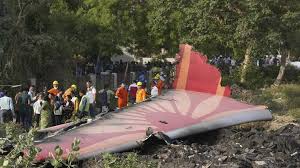Air India Ahmedabad crash: Veteran NTSB investigator on what the video footage reveals, focus of the probe

Ahmedabad | June 13, 2025 — The Air India Flight AI171 crash in Ahmedabad has left India mourning and the aviation world searching for answers. The Boeing 787 Dreamliner went down just seconds after takeoff, killing almost everyone on board. In response, a veteran investigator from the U.S. National Transportation Safety Board (NTSB) has joined Indian authorities to examine early evidence — especially the chilling video footage that captured the final moments.
This video footage, combined with data from the black boxes, could offer a full picture of what went wrong. Investigators are now focusing on five key areas, all of which could help explain the aircraft’s rapid loss of control after takeoff.
📹 What the Video Footage Shows
Security cameras from the airport and nearby areas recorded the takeoff. At first, everything looked normal. The aircraft lifted off the ground and started to climb. But within 20 seconds, it dipped sharply. It never gained proper altitude and crashed just 2.5 km from the runway.
The footage suggests some critical problems:
- Landing gear was still down during the short flight.
- Flaps appeared to be retracted, which reduces lift — especially dangerous during takeoff.
- The plane didn’t seem to reach a safe climbing angle.
If confirmed, these clues could point to serious issues in configuration or procedure.
🔍 What the NTSB Investigator Is Focusing On
The U.S. investigator, experienced in high-profile air crash cases, is working with India’s DGCA and Air India’s engineering team. Here are the five key areas of the probe:
1. Takeoff Configuration
Investigators are examining whether the aircraft’s takeoff settings were correct. Flaps help generate lift, and keeping the landing gear down creates drag. If pilots forgot to deploy flaps, or if a system failed to extend them, the plane could lose lift quickly.
A misconfigured takeoff often leads to what pilots call “lift starvation.” That alone could have made it impossible for the plane to stay airborne in Ahmedabad’s hot summer weather.
2. Engine Performance
There were no loud bangs or fireballs seen in the early footage. This rules out a visible engine explosion. But investigators are still checking for uneven thrust or other engine problems.
They’ll study black box data to find out if both engines delivered enough power. Even a partial thrust loss could be deadly during takeoff.
3. Pilot Actions and Human Factors
The cockpit voice recorder (CVR) will reveal what the pilots said during those final seconds. Did they notice any errors? Did any alarms go off? Investigators are also reviewing the pilots’ training history, hours flown, and health records.
Small human errors — especially under stress — can quickly escalate into major disasters.
4. Weather and Environment
On the morning of the crash, temperatures in Ahmedabad reached 39°C. Heat reduces air density. This condition, known as “high density altitude,” can reduce both lift and engine performance.
Investigators are comparing environmental data with the aircraft’s load and configuration. A heavy aircraft in hot weather may struggle to take off if anything else goes wrong.
5. Technical History and Maintenance
The Boeing 787 involved had recently undergone a standard check. Investigators are reviewing its maintenance logs. Any recent repair notes, deferred issues, or part replacements will be scrutinized.
Even a small mechanical oversight — like a malfunctioning flap actuator — can prove fatal if it occurs at the wrong moment.
🧠 Why the NTSB’s Role Matters
The U.S. NTSB brings years of experience in crash investigation. Their methods include digital flight simulations, human-factor testing, and root-cause analysis.
Their involvement also ensures transparency. With Boeing based in the U.S., the NTSB can independently verify if the aircraft had any design-related risks or unresolved technical bulletins.
⏱️ What Happens Next
The black boxes — including the flight data recorder and the CVR — are already with investigators. A preliminary report will likely come out within 10 days. That report will highlight basic facts and recommend any immediate safety actions for similar aircraft.
A full investigation may take several months. The final report could bring new safety rules, training changes, or even aircraft design updates.
🧾 Early Takeaways
- The video points to configuration issues — like flap settings and landing gear position.
- No explosion or bird strike is visible, suggesting an internal or procedural issue.
- Hot weather and load may have worsened a small problem into a fatal one.
- Experts are combing through data to find whether pilot error, system failure, or both caused the crash.
🚨 Conclusion
The crash of Air India Flight AI171 is a grim reminder of how quickly things can go wrong during takeoff — one of the most sensitive flight phases. The presence of a top NTSB investigator offers some hope that the truth will emerge clearly and quickly.
Families deserve answers. The industry needs lessons. And global regulators will be watching closely to ensure that this tragedy leads to stronger safety rules for everyone.






